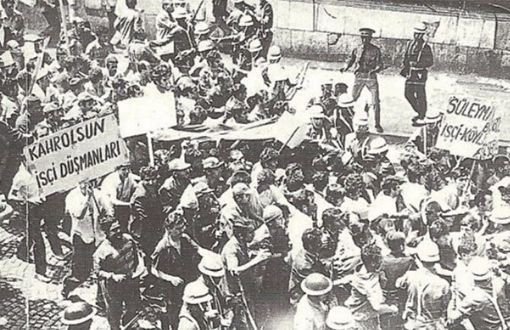"On June 15-16, 1970, the working class of Turkey stood up against the capital and government. June 15-16, 1970 is one of the most glorious days of struggle waged by the working class of Turkey. June 15-16 is the day when the working class mobilized to protect its right to unionize."
Today is June 15, 2020. As commemorated by the Public Services Employees Union of Turkey (Genel-İş) in above words, it marks the 50th anniversary of "June 15-16 Great Worker Resistance" in Turkey, which is one of the cornerstones of the labor movement and unionism in the country.
But what happened on June 15-16, 1970? Why is it so important that it is still marked today, especially by the Confederation of Progressive Trade Unions of Turkey (DİSK) and the unions affiliated with it?
Here is a brief look at the history of labor movement and unionism in Turkey and the incidents of June 15-16, 1970.
The Law on Unions and two confederations
The history of labor unions in Turkey dates back to 1947, when the one-party period had just been over. With the Law on Unions passed and enacted by the Parliament on February 20, 1947, employers and workers were, for the first time, granted the right to unionize in Turkey. [1]
It was on July 31, 1952 that the Confederation of Turkish Trade Unions (TÜRK-İŞ) was established as "the first nationwide trade union organization" in the country. For the next 15 years, it was also the only confederation in that regard.
As pointed out by Oya Baydar in her 1998 book, unions and labor movement gained momentum in Turkey especially after 1963.
With the left movement gaining ground around the same time, the DİSK was founded on February 13, 1967 as an "independent and democratic class-based organization" and as an "alternative and rival" to the TÜRK-İŞ.
While the founders of the DİSK were also among the founders and members of the Workers' Party of Turkey (TİP) dated 1961, it was with the establishment of the DİSK that the notions of "class" and "class struggle" became a part of the movement of unionism in Turkey. [2]
From 1970 till the military coup on September 12, 1980, hundreds of unions were established in Turkey and some powerful TÜRK-İŞ unions joined the DİSK, [3] which now had over 500 thousand members across the country. [2]
Process leading up to the June 15-16
The process leading up to the incidents of June 15-16 was triggered by a legislative proposal and its approval by the Parliament.
In 1970, the Republican People's Party (CHP) and the ruling Justice Party (AP) prepared law drafts foreseeing amendments to the Law no. 274 on Unions and the Law no. 275 on Strike and Lockout. These two law drafts were then combined into a single legislative proposal at the commission and referred to the Parliament to be debated and voted.
As noted by daily Evrensel, the proposal, which supposedly aimed to "create a powerful unionism" in Turkey, foresaw restrictions on unionization and right to strike, which would, in practice, make it harder for the workers to leave TÜRK-İŞ membership for the DİSK. Prepared with the contributions of the TÜRK-İŞ itself, the proposal was blamed for "aiming to paralyze and liquidate the DİSK and the unions affiliated with it." [4]
On June 12, 1970, the legislative proposal was approved by the votes of 230 MPs against four. All parties, except for the TİP, voted in favor.
Workers took to the streets in İstanbul and İzmit
The approval of this legislation by the Parliament sparked an outrage especially among the workers who were members of the DİSK. Groups called "Constitutional Resistance Committees" were formed in workplaces in İstanbul and Turkey's industrial province of İzmit.
Protests started three days after the legislation passed the Parliament. On June 15, 1970, over 70 thousand workers from 113 workplaces in İstanbul and İzmit [5] first entered the factories and just waited there without working. Then, they left the factories and started to march in protest.
While the workers in the Anatolian side of İstanbul started to march towards Kartal district, those in the European side also joined the protests, marching from Eyüp district towards Topkapı. While workers in Bakırköy district closed the main arterial road called "Londra Asfaltı" to traffic, those working in Levent marched towards Şişli and Taksim.
On June 16, the protests continued with the participation of more workers. It was estimated that over 100 thousand workers joined the protests on June 16. On this day, there were also mass demonstrations in the Aegean province of İzmir and the capital city of Ankara. [6] Members of not only the DİSK, but those of the TÜRK-İŞ reportedly joined the protests as well.
Martial law and lawsuits ensued the protests
As the police failed to disperse the protesters, military forces intervened against the workers, especially in İstanbul. In the ensuing incidents, workers Yaşar Yıldırım, Mustafa Bayram and Mehmet Gıdak, police officer Yusuf Kahraman and shop owner Abdurrahman Bozkurt lost their lives. [7]
The Council of Ministers proclaimed martial law in İstanbul, city center of Kocaeli province and its district of Gebze. The Martial Law Command declared a curfew from 9 p.m. to 5 a.m. and banned all types of demonstrations and meetings to be held in the related areas. [8]
While the martial law was in force for a three-month period, several lawsuits were filed into the incidents of June 15-16. As part of one of these lawsuits, DİSK executives faced 3 months to 7 years in prison. All of the arrested defendants were released on September 26, 1970 after the martial law ended on September 17. The lawsuit continued for 14 years. All defendants were acquitted in December 1984. [9]
According to a report published on the Türkiye Solu (Turkey's Left) Journal 10 months after June 15-16, 4,318 workers were laid off without compensation and blacklisted for their participation in the protests. [10]
As for the controversial legislation that sparked an outrage among the workers and led to the "June 15-16 Great Worker Resistance" in Turkey, it was approved by Cevdet Sunay, the then President of Turkey, on August 6, 1970 amid all objections and protests.
In response, the TİP and CHP, which changed its stance, appealed to the Constitutional Court against the legislation. With its judgement dated February 8-9, 1971, the Constitutional Court repealed the law. [11]
'A turning point in Turkey's democratic history'
The DİSK considers June 15-16, 1970 to be one of the turning points in its own history and that of the working class as well as in the democratic history of Turkey. Marking the 50th anniversary of its foundation three years ago, the DİSK referred to the "Great Worker Resistance" as follows:
"Not long after its formation, DİSK began to attract workers. Those who organized under its banner succeeded in advancing the class movement with strikes and labor action. In time, the governments of the era prepared new union laws to incapacitate progressive unions and eliminate DİSK. In time, a general strike and other labor action that was organized on 15-16 June 1970 has come to be perceived as a turning point in Turkey's democratic history."
On the other side, as rightly pointed out by Canan and Yıldırım Koç in their 2008 book on the history of the DİSK, "June 15-16 has a special place in the movement of working class and unionism in Turkey as it was the first protest by workers unionized in different confederations, working in different sectors and different cities for their non-wage rights." [12]
'They were there with their class identity'
Zafer Aydın, who has recently published a book named "İşçilerin Haziranı: 15-16 Haziran (The June of Workers: June 15-16), has also explained the importance of these two days to daily BirGün briefly as follows:
"First of all, June 15-16 derives its importance from the fact that it was the largest-scale movement of resistance by workers in the Republican history and it was done with a political demand. Workers who filled the streets asserted their existence with their class identities and attitudes.
"The CHP, which supported the legislation at the Parliament, objected against it at the Senate in line with a decision taken by its Party Assembly. In that sense, the CHP discovered the working class and its power.
"June 15-16 also put a stop to the debates among the socialist left as to whether working class was a social subject or not. It opened new doors for the march of unionist movement and worker struggle."
As further suggested by Aydın in this interview, "only a very few worker protests managed to bring out an effect on such a wide scale."
That being the case, what happened 50 years ago today does still have an important place in the collective memory of working class and left movement in Turkey, serving as an important reference point as well as a strong guiding light. (SD)
Sources
[1] Türkiye'de İşçi Hareketi: 1908-1984 (Worker Movement in Turkey), M. Şehmus Güzel, s.154
[2] Türkiye'de Sendikacılık Hareketi (Movement of Unionism in Turkey), Oya Baydar, s.17
[3] age. s.13
[4] DİSK Tarihi: Efsane mi, Gerçek mi? (1967-1980) (History of the DİSK, Legend or Truth?), Canan Koç - Yıldırım Koç, s.138
[5] age. s.150
[6] Büyük İşçi Direnişi: 15-16 Haziran (Great Worker Resistance: June 15-16), https://www.evrensel.net/haber/115298/buyuk-isci-direnisi-15-16-haziran
[7] DİSK Tarihi: Efsane mi, Gerçek mi? (1967-1980), Canan Koç - Yıldırım Koç, s.151
[8] age. s.156
[9] age. s.157
[10] age. s.169
[11] Büyük İşçi Direnişi: 15-16 Haziran, https://www.evrensel.net/haber/115298/buyuk-isci-direnisi-15-16-haziran
[12] DİSK Tarihi: Efsane mi, Gerçek mi? (1967-1980), Canan Koç - Yıldırım Koç, s.137










.jpg)
